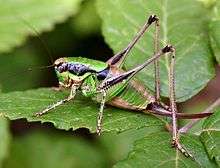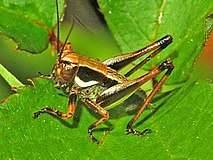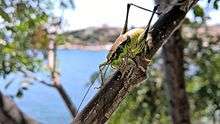Eupholidoptera chabrieri
Eupholidoptera chabrieri is a species of katydid belonging to the subfamily Tettigoniinae.
| Eupholidoptera chabrieri | |
|---|---|
| Male | |
 | |
| Female | |
| Scientific classification | |
| Kingdom: | Animalia |
| Phylum: | Arthropoda |
| Class: | Insecta |
| Order: | Orthoptera |
| Suborder: | Ensifera |
| Family: | Tettigoniidae |
| Genus: | Eupholidoptera |
| Species: | E. chabrieri |
| Binomial name | |
| Eupholidoptera chabrieri (Charpentier, 1825) | |
Subspecies
- Eupholidoptera chabrieri bimucronata (Ramme, 1927)
- Eupholidoptera chabrieri brunneri (Targioni-Tozzetti, 1881)
- Eupholidoptera chabrieri chabrieri (Charpentier, 1825)
- Eupholidoptera chabrieri galvagnii Adamovic, 1972
- Eupholidoptera chabrieri garganica La Greca, 1959
- Eupholidoptera chabrieri schmidti (Fieber, 1861)
- Eupholidoptera chabrieri usi Adamovic, 1972
Distribution and habitat
These crickets are mainly present in France, southern Switzerland, Italy, Slovenia, Romania and in Greece.[1] They can be encountered in forest edges, clearings, thickets and shrubs.
Description
The adults reach 20–30 millimetres (0.79–1.18 in) of length. The basic coloration of the body varies from green to light green and yellow green. The top of the head is orange, with a few black spots in the front.
The compound eyes are pale brown. The antennae are longer than the body. The flat, extended pronotum shows a black band, with an orange-yellow lateral contour. The abdomen is green and quite thick, with a yellow bottom and a black last segment. This species is remarkably long-legged, with a striking pattern of black spots and drawings and small spines on the hind legs.
In the females the tiny dark brown wings are partially hidden under the pronotum, while the males have very short tegmina. The females have a slightly curved ovipositor, which is somewhat shorter than the body.
Biology
Adults can be found from July through September. This species start breeding in July. Only eggs overwinter, hatching in next April. The song of these crickets consists of short, high-frequency single sounds, usually presented in series at a distance of a few seconds.
Gallery
 Young male
Young male- Female, dorsal view
.jpg) Male, detail on cerci
Male, detail on cerci Eupholidoptera chabrieri (female). Kassiopi, Corfu, Greece
Eupholidoptera chabrieri (female). Kassiopi, Corfu, Greece
References
- Ciplak B., K.-G. Heller, F. Willemse (2009) - Review of the genus Eupholidoptera (Orthoptera, Tettigoniidae): different genitalia, uniform song Zootaxa 2156: 1–75 (Publication date: 7/13/2009)